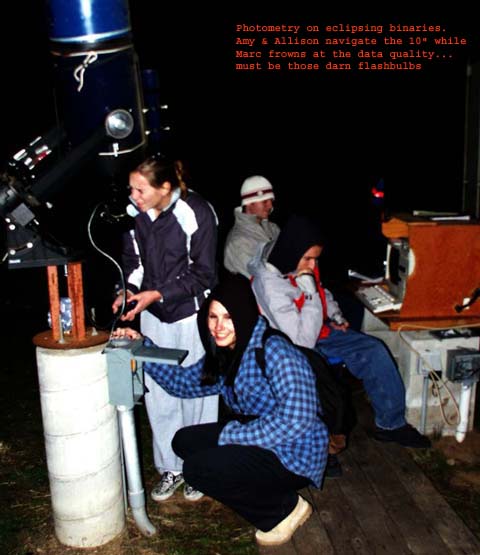Astro 8A: Observational
Astronomy
Pre-requisite Challenge - Think you qualify to Take Astro 8A w/o the Astro 3,4,5,7 pre-co-req? We're here to help!
===========================================================================================================================
We do use software in Astro 8A for working with your Astrophoto project. Free software: C2A, CCDOPS, Registax 5.1, Photoshop (or something similar). These are all installed on the Room 705 and Observatory computers,
This is the Astronomy lab class. Paired
with Astro 3, 4, 5 or 7, students have a complete UC and CSU university-level lab
science GE transfer class. Unlike some lab sciences, you do not have to take Astro
8A at the same time as Astro 3 or 4 or 7. The lecture and lab classes are not structured
to be closely parallel in material, due partly to the randomness of weather.
Overview
Astronomy is a bit unique in that we are
very dependent on the unpredictability of the weather as to what we'll be
doing. Because of this, the class has a more free-wheeling style to it than
my other classes, which I think also makes it more fun. On clear nights,
we meet at Cabrillo
Observatory, where we each work on projects and I circulate around helping people keep forward momentum, all in an informal way. On cloudy nights, we meet in room 705 and do in-class
labs, videos with quizzes afterward, and making progress on your photo project. On average we get to go to the observatory
about half the time. In both situations, our projects usually focus on measurements.
Here's a helpful page on the art of measurement.
In-class labs focus on quantitative measurement and calculations using elementary
equations which I'll help you with.  Lab assistant Becky Snow and I circulate about and help
keep progress progressing. The last day of the semester, during finals week,
we have a little photo exhibition of student work, a pot luck, and we get
to assemble your class-wide set of light curves on our project variable stars.
Bonus points are given for the most accurate brightnesses. We also have a
short final exam. It's a fun class! Besides my Astro
27 and Astro 25
field trip classes, this is my most enjoyable class.
Lab assistant Becky Snow and I circulate about and help
keep progress progressing. The last day of the semester, during finals week,
we have a little photo exhibition of student work, a pot luck, and we get
to assemble your class-wide set of light curves on our project variable stars.
Bonus points are given for the most accurate brightnesses. We also have a
short final exam. It's a fun class! Besides my Astro
27 and Astro 25
field trip classes, this is my most enjoyable class.
Because we never know how the weather will
cooperate, the class operates with a lot of flexibility. I've come up with many different projects with the
goal of picking the right project for the right opportunity.
Night Sky Projects at the Observatory Can Include...
* Estimating brightnesses of eclipsing, irregular, and pulsating variable stars
* Logging meteors and meteor showers
* Timing occultations of stars by the moon
* Timing eclipses and transits of Jupiter's 4 moons
* Estimating the heights of mountains and crater walls on the moon using simple
shadows
* Using our big scope (the 12" under the dome) to take a stunning astrophoto (you'll get plenty of help on this one). Your photo will be published in our on-line gallery.
In-Class Projects on Cloudy Nights ...
* PBS video programs and associated quizzes
* Charting the orbit of Mercury using Kepler's method
* Identifying and measuring craters and mountains on the moon
* Estimating the orbit of a meteor shower using simple
observations
* Choosing a beautiful subject for your astrophoto project
* Polishing up your astrophotos and making
wall-suitable framed prints
* Doing real science classifying galaxies for professional astronomers or classifying variable stars, also on Zooniverse

Charlie is dumbfounded - after a semester
of estimating the brightness of Cepheid variable star T Monocerotis
and all the calculations of all the students to place them on a single
graph.... it actually shows a consistent pattern, not random noise!
|

This could be you and your class!... with their
astrophoto projects in hand. See these photos now decorating the walls
of our new observatory. On the white board are their excellent visual
magnitude estimates of our variable stars all plotted together.
|
Enjoy these
pictures taken during our adventures in and out of the classroom, and consider
joining us!
 Lab assistant Becky Snow and I circulate about and help
keep progress progressing. The last day of the semester, during finals week,
we have a little photo exhibition of student work, a pot luck, and we get
to assemble your class-wide set of light curves on our project variable stars.
Bonus points are given for the most accurate brightnesses. We also have a
short final exam. It's a fun class! Besides my Astro
27 and Astro 25
field trip classes, this is my most enjoyable class.
Lab assistant Becky Snow and I circulate about and help
keep progress progressing. The last day of the semester, during finals week,
we have a little photo exhibition of student work, a pot luck, and we get
to assemble your class-wide set of light curves on our project variable stars.
Bonus points are given for the most accurate brightnesses. We also have a
short final exam. It's a fun class! Besides my Astro
27 and Astro 25
field trip classes, this is my most enjoyable class.
